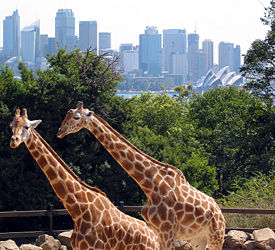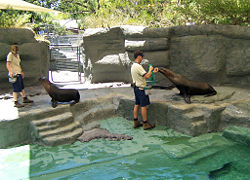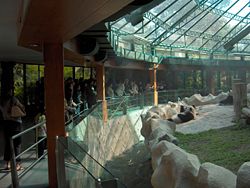Difference between revisions of "Zoo" - New World Encyclopedia
Rick Swarts (talk | contribs) |
({{Contracted}}) |
||
| Line 1: | Line 1: | ||
| − | {{Claimed}} | + | {{Claimed}}{{Contracted}} |
[[Image:Sydney_taronga_zoo.jpg|thumb|right|275px|Giraffes in Sydney's [[Taronga Zoo]]]] | [[Image:Sydney_taronga_zoo.jpg|thumb|right|275px|Giraffes in Sydney's [[Taronga Zoo]]]] | ||
A '''zoological garden''', '''zoological park''', or '''zoo''' is a facility in which animals are confined within enclosures and displayed to the public, and in which they may also be bred. The term zoological garden refers to the [[biology|biological]] [[academic discipline|discipline]] [[zoology]], which derives from [[Greek language|Greek]] | A '''zoological garden''', '''zoological park''', or '''zoo''' is a facility in which animals are confined within enclosures and displayed to the public, and in which they may also be bred. The term zoological garden refers to the [[biology|biological]] [[academic discipline|discipline]] [[zoology]], which derives from [[Greek language|Greek]] | ||
Revision as of 15:28, 11 June 2007
A zoological garden, zoological park, or zoo is a facility in which animals are confined within enclosures and displayed to the public, and in which they may also be bred. The term zoological garden refers to the biological discipline zoology, which derives from Greek Ζωο("animal"), and λογος ("study"). The term was first used in 1828 for the London Zoological Gardens, soon abbreviated to "zoo."
History
The predecessor of the zoological garden is the menagerie that has a long history from the Middle Ages to modern times. Menagerie is the term for a historical form of keeping wild and exotic animals in human captivity and therefore a predecessor of the modern zoological garden. The term was foremost used in seventeenth century France originally for the management of the household or domestic stock, but later primarily for an aristocratic or royal animal collection. The French-language "Methodical Encyclopaedia" of 1782 defines a menagerie as an "establishment of luxury and curiosity." Later on the term was referred even to travelling animal collections that exhibited wild animals at fairs across Europe and the Americas.
The oldest existing zoo, the Vienna Zoo in Austria, evolved from such an aristocratic menagerie founded in 1752 by the Habsburg monarchy.
The first zoo founded primarily for scientific and educational reasons was the Ménagerie du Jardin des Plantes in Paris (1794). The founders and members of the Zoological Society of London adopted the idea of the early Paris zoo when they established London Zoo in 1828.
The success of London Zoo set off a wave of similar establishments. The first zoological garden established in Australia was Melbourne Zoo in 1860. In the same year the first zoo of the United States opened to the public in New York City (Central Park Zoo), although earlier, in 1859, the Philadelphia Zoological Society had made an effort to establish a zoological park, but delayed due to the American Civil War.
When ecology emerged as a matter of public interest through the 1970s, a few zoos began to consider making conservation their central role, with Gerald Durrell of the Jersey Zoo, George Rabb of Brookfield Zoo, and William Conway of the Bronx Zoo (Wildlife Conservation Society) leading the discussion. Since then, zoo professionals became increasingly aware of the need to engage themselves in conservation programmes and the American Zoo Association soon asserted that conservation had become its highest priority.[1][2][3][4]
Appearance

Many zoos in Europe and North America keep animals in enclosures that attempt to replicate their natural habitats, for the benefit of both resident animals and visitors. They may have special buildings for nocturnal animals, with dim lighting during the day, so the animals will be active when visitors are there, and brighter lights at night to ensure that they sleep. Special climate conditions are created for animals living in radical environments, such as penguins. Special enclosures for birds, insects, fishes and other aquatic life forms have also been developed.
A petting zoo (also called children's farms or children's zoos) features a combination of domestic animals and some wild species that are docile enough to touch and feed. Petting zoos are popular with small children. To ensure the animals' health, the food is supplied by the zoo, either from vending machines or a kiosk nearby. There are independent and zoo-based petting zoos.
Some zoos have walk-through exhibits where visitors enter enclosures of non-aggressive species, such as lemurs, marmosets, birds, lizards, turtles etc. Visitors are asked to keep to paths and avoid showing or eating foods that the animals might snatch. The animals are not tame.
Conservation, education, research
| Conservation status |
|---|
| The risk of extinction |
| Extinction |
|
Extinct |
| Threatened |
|
Critically Endangered |
| Lower risk |
|
Conservation Dependent |
| See also |
Most modern zoos in Europe and North America display wild animals primarily for the conservation of endangered species and for educational and research purposes, and secondarily for the entertainment of visitors.[5][6]
In 1993, the World Association of Zoos and Aquariums (WAZA), formerly known as the International Union of the Directors of Zoological Gardens, produced its first conservation strategy. In November 2004, WAZA adopted a new strategy that sets out the aims and mission of zoological gardens of the twenty-first century.[7]
The breeding of endangered species is coordinated by cooperative breeding programmes containing international studbooks and coordinators, who evaluate the roles of individual animals and institutions from a global or regional perspective. There are regional programmes for the conservation of endangered species:
- America: Species Survival Plans SSP (American Zoo and Aquarium Association AZA, Canadian Association of Zoos and Aquariums)
- Europe: European Endangered Species Program EEP (European Association of Zoos and Aquaria)
- Australasia: Australasian Species Management Program ASMP (Australasian Regional *Association of Zoological Parks and Aquaria ARAZPA)
- Africa: African Preservation Program APP (African Association of Zoological Gardens and Aquaria PAAZAB)
- Japan: Conservation activities of Japanese Association of Zoos and Aquariums JAZA
- South Asia: Conservation activities of South Asian Zoo Association for Regional Cooperation SAZARC
- South East Asia: Conservation activities of South East Asian Zoo Association SEAZA
People for the Ethical Treatment of Animals (PETA) rejects the claim that the purpose of most zoos is to undertake research, to aid in conservation, or to educate. PETA alleges that most zoo research is in fact geared toward finding new ways to breed and keep animals in captivity, so that if zoos ceased to exist so would the need for most of their research. PETA writes that zoos usually favor exotic or popular animals over threatened or endangered local wildlife, in order to draw crowds.[8]
PETA quotes a curator from the Smithsonian National Zoological Park in Washington, D.C., who followed 700 visitors over the course of five summers and concluded that "it didn’t matter what was on display ... people [were] treating the exhibits like wallpaper ... officials should stop kidding themselves about the tremendous educational value of showing an animal behind a glass wall."[9]l
Criticism of zoos

Many animal rights activists disapprove of zoos because they interpret zoos as human domination over equal creatures and criticize their educational value as being superficial and useless.
Some animal welfare groups however do not fundamentally reject the existence of zoological gardens, but seek to remedy the unnatural and unhealthy conditions in which many captive animals live—particularly the problem of small cages lacking environmental enrichment. Some zoos continue to provide their animals inadequate care, particularly those zoos that are unlicensed, those that are overly commercially-concerned and those that suffer from lack of money. Stereotypical behavioral patterns such as pacing, rocking and swaying may indicate stress or suffering of animals in unsuitable enclosures. For example, unhealthy elephants may sway continuously from side to side or rock back and forth.
The majority of the large non-profit and scientifically oriented institutions are working to improve their animal enclosures, although constraints like size and expense make it difficult to create ideal captive environments for some species (for example, dolphins and other whales).[10][11]
Regulation of zoos in the United States
In the United States, any public animal exhibit must be licensed and inspected by the United States Department of Agriculture.[12] Zoos may also require special licenses to meet the requirements of their particular locality. For a variety of reasons. such as (zoonotic disease, possession of controlled drugs for veterinary use, etc) a zoo in the United States may be inspected and regulated by other agencies including the Food and Drug Administration, Environmental Protection Agency, Drug Enforcement Agency, Occupational Safety and Health Administration, and others.
Depending on the animals they exhibit, the activities of zoos are regulated by laws including the Endangered Species Act, the Animal Welfare Act, the Migratory Bird Treaty Act of 1918 and other laws.[13]
Additionally, zoos in North America may choose to pursue accreditation by the Association of Zoos and Aquariums. To achieve accreditation, a Zoo must pass a rigorous application and inspection process and meet or exceed the AZA's standards for animal health and welfare, fundraising, zoo staffing, and involvement in global conservation efforts. Inspection is performed by three experts (typically one veterinarian, one expert in animal care, and one expert in zoo management and operations) and then reviewed by a panel of twelve experts before accreditation is awarded. This accreditation process is repeated once every five years.
The AZA estimates that there are approximately 2,400 animal exhibits operating under USDA license as of February 2007; fewer than 10% have achieved accreditation.[14]
Some zoos concentrate on animals of geographical regions, on animals of the water or attempt to exhibit their animals in a different way. Some of these institutions, mainly those who evolved from former amusement parks, connect entertainment elements with exhibiting live animals.
Wild animal parks
Wild animal parks are larger than the classical zoo. The first of this new kind of animal park was Whipsnade Park which opened in 1931 in Bedfordshire, England. This park, owned by the Zoological Society of London, covers 600 acres (2.4 km²) and is still one of Europe's largest wildlife conservation parks where animals are kept within sizeable enclosures. Since the early 1970s a 1,800-acre parcel (7 km²) in the Pasqual Valley near San Diego also accommodates a remarkable zoo, the San Diego Wild Animal Park that is run by the Zoological Society of San Diego. Another zoo comparable to these wild animal parks is the Werribee Open Range Zoo in Melbourne, Australia, focusing on displaying animals living in a wide open savanna. This 500-acre zoo is managed by the Zoological Parks and Gardens Board which also manages Melbourne Zoo. One of only 2 American state supported zoo parks is the 535-acre North Carolina Zoo located in Asheboro, North Carolina.
Public aquaria
The first public aquarium was opened in London Zoo in 1853. This was followed by the opening of public aquaria in Europe (for example, Paris 1859, Hamburg 1864, 1868, Berlin 1869, Brighton 1872) and the United States (Boston 1859, Washington 1873, San Francisco 1894, New York 1896). In 2005 the non-profit Georgia Aquarium with more than 8 million US gallons (30,000 m³; 30,000,000 liters) of marine and fresh water, and more than 100,000 animals of 500 different species opened in Atlanta, Georgia. The aquarium's specimens include whale sharks and beluga whales.
Animal theme parks
An animal theme park is a combination of an amusement park and a zoo, mainly for entertaining and commercial purposes. Marine mammal parks such as Sea World are more elaborate dolphinariums keeping whale species and containing additional entertainment attractions. Another kind of animal theme park opened in 1998 - Disney's Animal Kingdom in Orlando, Florida. This commercial park established by the Walt Disney Company is similar to wild animal parks according to size (550 acres, 2 km²), but differs in intention and appearance since it contains more entertainment and amusement elements than the classical zoo, such as a stage shows, roller coasters, and mythical creatures. Another famous one is the Marineland in Niagara Falls, Ontario, Canada.
See also
- List of zoos
- List of zoo associations
- Animals in captivity
- Environmental enrichment
- Zoology (includes a list of prominent zoologists)
- Biodiversity
- Endangered species
- Wildlife conservation
- Ex-situ conservation
- In-situ conservation
- Extinction
- List of Conservation topics
- Fossil Parks
- Conservation movement
- National Park
- Wildlife Sanctuary
- Conservation
- International Park
- National Forest
- International Network of Geoparks
- Zoo Emergency Response Team
Notes
- ↑ Vernon N. Kisling (ed.): Zoo and Aquarium History, Boca Raton 2001. ISBN 0-8493-2100-X
- ↑ R. J. Hoage, William A. Deiss (ed.): New Worlds, New Animals, Washington 1996. ISBN 0-8018-5110-6
- ↑ Elizabeth Hanson: Animal Attractions, Princeton 2002. ISBN 0-691-05992-6
- ↑ David Hancocks: A Different Nature, Berkeley 2001. ISBN 0-520-21879-5
- ↑ Colin Tudge: Last Animals in the Zoo: How Mass Extinction Can Be Stopped, London 1991. ISBN 1-55963-157-0
- ↑ http://www.biaza.org.uk/resources/library/images/MANIFESTO.pdf John Regan Associates: Manifesto for Zoos, 2004
- ↑ http://www.waza.org/conservation/wzacs.php The World Zoo and Aquarium Conservation Strategy
- ↑ "Zoos: Pitiful Prisons", People for the Ethical Treatment of Animals.
- ↑ Booth, William. "Naked Ape New Zoo Attraction; Surprise Results From People-Watching Study," The Washington Post, March 14, 1991, cited in "Zoos: Pitiful Prisons", People for the Ethical Treatment of Animals.
- ↑ Bryan G. Norton, Michael Hutchins, Elizabeth F. Stevens, Terry L. Maple (ed.): Ethics on the Ark. Zoos, Animal Welfare, and Wildlife Conservation, Washington, DC 1995. ISBN 1-56098-515-1
- ↑ Randy Malmud: Reading Zoos. Representations of Animals and Captivity, New York 1998. ISBN 0-8147-5602-6
- ↑ [1]
- ↑ [2]
- ↑ [http://www.aza.org/Accreditation/AccreditationIntro/
- Hahn, Daniel (2003). The Tower Menagerie. London: Simon & Schuster. ISBN 0-7432-2081-1.
- Baratay, Eric and Hardouin-Fugier, Elisabeth (2002). Zoo: a History of the Zoological Gardens of the West. London: Reaktion. ISBN 1-86189-111-3.
Further reading
- Association of Zoos and Aquariums (AZA) North American Association of Zoos and Aquariums
- Zoos Worldwide Zoos, aquariums, animal sanctuaries and wildlife parks
- World Association of Zoos and Aquariums
- Zoological Gardens keeping Asian Elephants
- AIZA
Credits
New World Encyclopedia writers and editors rewrote and completed the Wikipedia article in accordance with New World Encyclopedia standards. This article abides by terms of the Creative Commons CC-by-sa 3.0 License (CC-by-sa), which may be used and disseminated with proper attribution. Credit is due under the terms of this license that can reference both the New World Encyclopedia contributors and the selfless volunteer contributors of the Wikimedia Foundation. To cite this article click here for a list of acceptable citing formats.The history of earlier contributions by wikipedians is accessible to researchers here:
The history of this article since it was imported to New World Encyclopedia:
Note: Some restrictions may apply to use of individual images which are separately licensed.



